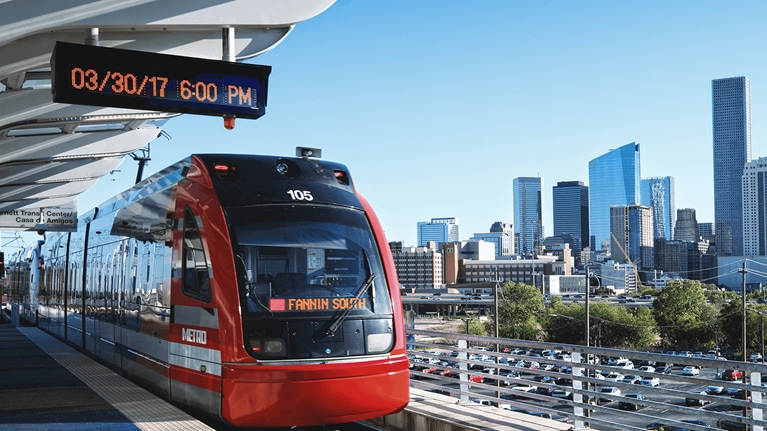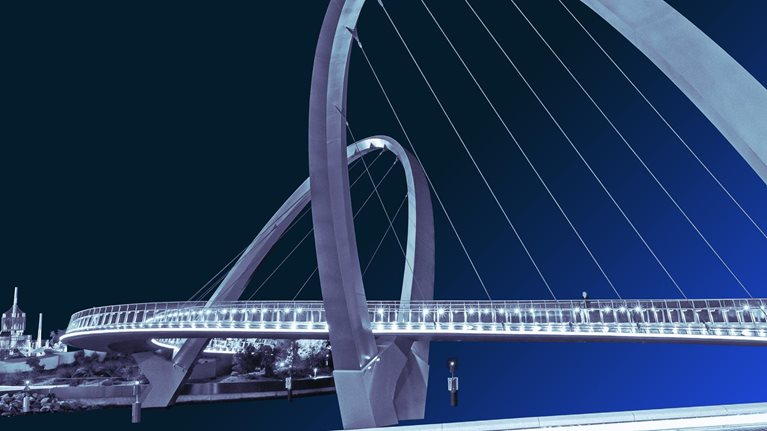It’s the sort of thing that might keep state leaders up at night. A heavily trafficked route is made impassible by the second road excavation in a year, triggering complaints from frustrated commuters and business owners, or worse: an accident in a work zone.
These are exactly the types of scenario a “dig once” policy is designed to avoid.
While infrastructure improvements are generally welcomed by the public, they can be highly disruptive. A dig-once approach seeks to mitigate that pain by coordinating the delivery of several infrastructure projects simultaneously, rather than carrying out each one separately. For example, adding more lanes to a highway requires excavation; so does laying new broadband cables to bring high-speed internet service to an unserved rural community. Rather than dig up the road twice, states could dig just once to accommodate both projects.
Curbing disruptions is not the only potential benefit. With hundreds of billions of federal dollars being reinvested in America under the Bipartisan Infrastructure Law (BIL), harmonizing projects through a dig-once approach could help states save money. If complemented by sophisticated digital tools, the approach could also help states manage shortages of building supplies and construction workers more efficiently and secure more BIL funding. And it could pave the way for more integrated infrastructure systems that could better serve households and businesses and advance public-policy goals, supporting lives and livelihoods.
Granted, coordinating major infrastructure projects across multiple agencies, entities, and stakeholders is not without its challenges, but there are strategies that could help tackle some of the most common ones.
Overcoming barriers
By reducing the need for multiple excavations, a dig-once policy can promote better use of public resources, and potentially help mitigate property damage, service outages, traffic disruptions and accidents, and other potential hazards to public safety.1 The approach could also generate more bang for taxpayers’ dollars. A 2012 study by the US Government Accountability Office found that coordinating broadband and federal highway projects could generate cost savings ranging from 25 to 33 percent in urban areas and approximately 16 percent per mile in rural areas.2 Another analysis estimated that coordinating broadband installations with utility and transportation excavations is approximately ten times cheaper than doing a standalone dig, and that savings are most pronounced in high-density areas where underground installation is the only option.3
But coordinating multiple infrastructure projects faces many barriers. Three of the most common include the following4:
- Budget and funding rigidity. Creating flexibility within government budget timelines and federal program requirements could be beyond the remit of some government leaders focused on infrastructure projects. This challenge is often compounded if each entity in the process (such as utility agencies, telecom companies, transit agencies, and road owners in a city) has different capital agendas and funding processes that were created separately. Reconciling these to adapt to different timelines is unlikely. Also, some BIL funding must adhere to strict statutory guidelines that could thwart efforts to expand the scope of a project to include cross-agency priorities.
- Assessing and conveying the business case to initiate, prioritize, and sequence projects. Coordinating multiple public works can trigger higher costs up front, and it could be hard for governments to evaluate and measure the financial benefits of absorbing those initial costs. Leaders pursuing dig once may also find it difficult to evaluate the nonfinancial impact that projects could have on citizens’ lives.
- Coordination and implementation of projects across different time horizons and agencies. Once states have identified which projects to prioritize for a dig-once effort, coordinating their launch across myriad stakeholders such as government agencies, public-utility companies, subcontractors, and other private-sector actors can be difficult, especially with programs that roll out on different timelines and have different stage gates, permitting processes, and so on.
Though these hurdles may seem daunting, they are not necessarily insurmountable. Some states and cities have already implemented various “flavors” of dig once.5 Arizona, for example, requires its Department of Transportation (DOT) to coordinate with telecom companies during road construction projects along rural highways to install broadband conduits and help close the digital divide.6 Illinois, Maryland, and Minnesota also promote coordination between their DOTs and private broadband providers. The Michigan Infrastructure Council has a coordination portal that documents infrastructure construction and alerts owners to overlapping projects (see sidebar, “Flavors of dig once”).7
These variations of dig once suggest that there is potential for a range of solutions state and local leaders could explore to overcome common obstacles.
Here are five solutions to consider:
- Designate an infrastructure coordinator to better align projects and programs. By becoming a clearinghouse for which programs agencies are applying, and which projects will kick off and when, the coordinator could identify opportunities for overlap.
- Create a platform or forum to enhance coordination between the state and private sectors. This could be a portal, regular working sessions, stakeholder calls, designated councils, or other solutions. The idea is to keep communications flowing over which projects are planned, how they might roll out, and how everyone involved can improve coordination.
- Better inform planning by feeding in data on labor and material shortages. States may want to focus on staging and planning projects that have the most potential for impact and starting with those that are least impacted by shortages could do that.
- Put a single person in charge of “bundled” projects in their design and build/construction phases to ensure they can be done together. This point person could also focus on coordinating stakeholders, aligning and accelerating permitting processes, and ensuring things keep moving.
- Plan early and map it out. Using geospatial analysis can highlight where funding is dedicated and could identify areas of overlap and potential for dig-once approaches.
More sophisticated digital tools could also be harnessed to improve project design and delivery. For example, models that draw from multiple sources could be built on top of a geospatial map of the entire infrastructure portfolio and then layered with information on individual projects. This type of tailored visualization could allow state leaders to test multiple coordination options at once, prioritize projects according to estimated ROI, identify which ones have BIL funding, and help address material and labor supply shortages. These models could even evolve to enable advanced simulations to anticipate how factors such as flooding, wildfires, and other natural disasters, or fluctuations in public-transport passenger numbers, could impact infrastructure investments down the line.
But states don’t need to wait until they have sophisticated digital tools to kick off a dig-once policy. One central platform—even one as simple as a shared spreadsheet—managed by a designated leader could help support project planning, prioritization, and implementation. States can then consider building from a humble starting point to move toward longer-term solutions that could create multiple options for addressing core dig-once challenges. And those longer-term solutions could lay the foundation for a fully integrated state infrastructure system.
Integrated infrastructure systems
The advantages of dig once could go beyond saving money and reducing residents’ inconvenience. Looking more strategically, the approach can also help catalyze plans for more integrated infrastructure systems. For example, coordinating broadband and lead-pipe abatement could yield dividends for households and businesses simultaneously. Harmonizing transportation, transit, and electric-vehicle-charging stations could help drive more complementary transportation networks. And coordinating critical failure points around green-energy grids could create greater resilience against fires and storms.
With BIL delivering $550 billion in new spending over the next five years, states will have more resources to pool for dig-once priorities, including a more expansive vision of integrated infrastructure. They’ll also likely have wiggle room to combine BIL programs because the Federal Highway Administration allows states to transfer funding for some road and highway projects to other entities if it generates cost savings or brings greater expertise to the table.8
Moreover, if states can visualize more integrated infrastructure systems, this could help them secure more BIL funding. Some BIL grants will be doled out according to formulas, but others will be awarded on the strength of competitive applications. Framing community impacts through the lens of integrated infrastructure systems could distinguish applications from state, local, and tribal entities, while helping to ensure the funds they do receive are deployed wisely.
While coordinating infrastructure projects is not without challenges, the concept is already being proven in several states. And with the nation’s transportation, water, broadband, and other systems receiving a once-in-a-generation federal funding boost, dig once could make the process of upgrading infrastructure less painful for the public and deliver bigger benefits down the road.


